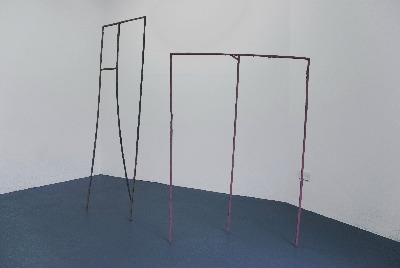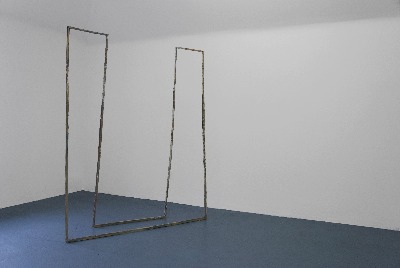The recent exhibition of Sara Barker’s Plant dreaming deep, curated by Aoife Tunney for FOUR Gallery, is sophisticated and subtle. Barker’s work situates itself at the boundary of sculpture; it questions the very nature of its own form. The situation of the structures works well, nested in the loft-room of the classic Georgian building that houses FOUR. I refer to the work as ‘structure’ rather than ‘sculpture’ as, although technically three-dimensional and removed from the wall, each consists of thin strips of cardboard and looks fragile enough that they risk falling over. It is this situation of the work between sculpture and relief that makes it absorbing; it cannot cachet from any single genre. The flatness of the work, though three-dimensional in space, holds onto its two-dimensionality through its sheerness of surface. This delicacy of form heightens one’s awareness of the solidity of the classical architecture that surrounds them – the linear shape of each piece referencing architecture’s unseen aspect, the grid.

Though it would seem easy to anthropomorphise these pieces, one can look at them from the purely logical standpoint. The delicately gaping joints splay the limbs of each work to a point from which one imagines they cannot return. The clean lines of modernism have been challenged and given another dimension; they have as it were broken from their confined frame. The works bear the scars of two-dimensionality; they are paint-spattered. Thus each seems as if it were recently pulled from the picture frame. The foundation of modernism was the grid, and upon its structure emotions were left to one side, the material alone speaking for the artist. Now we see a reversal of this nullification of emotion; the grid speaks. The vestiges of paint are remains of a lost situation, now invalid; one has removed oneself from the modernist remit. The lines are no longer rigid, but malleable, moveable; though too delicate, unreal. The evolution of form from painting to sculpture requires this step and Barker has provided it. The works manage to exist as basic structure and Barker admirably forgoes the usual sculptural upholstery that oftentimes attends such work.

The positioning of a singular more solid structure amongst the grid-works serves as a leap-too-far into three-dimensional form. The admirable concept of the other pieces in this show serves as a reminder of median structure. This piece appears completely evolved, and for that reason the transition is too determinate. It is the process of pulling two-dimensionality to its limit that is so enjoyable. The ‘will-it-fall-over’ aspect to the other pieces holds the viewer within the space and in the interaction of the artwork with that space; the solid-rigidity of the final structure offers no further questioning.

Sara Barker uses Plant dreaming deep to explore the constructed ‘living space’ of the house in relation to internal process. The works are singular and provide an interesting point of reckoning for sculptural work today.
Hilary Murray is a writer and PhD student at University College Dublin.